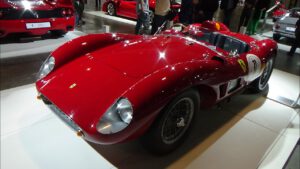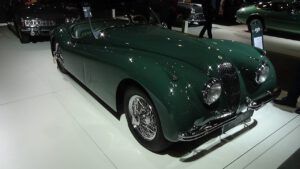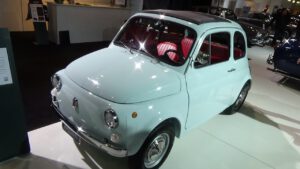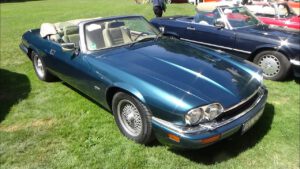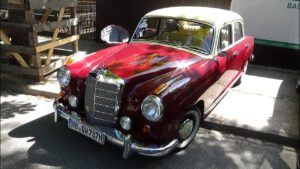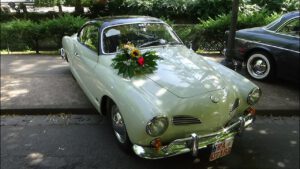What are the most iconic classic cars? Has your favourite made the list?
The Ultimate Grand Prix Cruiser: Mercedes Benz 300SL Gullwing
The Mercedes Benz 300SL Gullwing is one of a kind. Very rare and very expensive, collectors consider it the ultimate Grand Prix cruiser. RM Sotheby’s auctioned off a Mercedes-Benz 300 SL Gullwing for six million euros on 27 January 2022 in Phoenix, Arizona. The two-seater was launched in 1954 to great acclaim at the International Motor Sports Show in New York. It was the fastest sports car of its time and was manufactured up to 1963. Its continued success is because it is faster, more reliable and, apart from the heat generated in the interior, more comfortable than many other cars from the 1950s.
An engineering jewel: Jaguar XK120
Without the XK120, what would Jaguar have been? The Jaguar XK120 was born thanks to its engine. In 1948, Jaguar developed an open two-seater to present its new Jaguar XK engine at the London Motor Show. The bodywork served as a case to house this engineering jewel. The car caused a sensation, persuading William Lyons to put it into production. Car enthusiasts loved its beautiful design. The Jaguar XK120 was slim and curvaceous and sporty to the core. Its speed may seem modest: 180hp, but remember that this is the first production car to reach 120mph!
Goddess: Citroen DS
DS pronounced “Déesse” means goddess. This name is not an understatement for Citroen’s revolutionary car launched in 1955 at the salon de l’auto at the Grand Palais in Paris. It featured a flock of most innovative technologies: power steering, hydraulically-operated power transmission, disc brakes, steering pivot in the wheel axis, hydropneumatic suspension. The DS also had a bold line, a panoramic view, manoeuvrability and driving comfort without comparison with older models in France and Europe. The launch created a hype “DS Mania”. Le Figaro – a leading French newspaper – wrote on October 7th 1955 “the fever reaches its peak at the order desk”. Despite its high price of 930 000 francs the order books were full from the beginning.
Dynamic shapes and exuberant chrome : Chevrolet Corvette C1
The early Chevrolet Corvette C1 is an icon of the American motor world. It started in 1953 with dynamic shapes and exuberant chrome ornamentation. The body was made out of revolutionary glass fiber reinforced plastic material. The early model years didn’t have a powerful engine. But starting from 1955, thanks to the V8 engine, the Chevrolet Corvette finally became a great sales success, which continues into the eighth model generation today. Power output for this 1958 model was 290 hp. It was advertised as producing “One HP per cubic inch”.
Italian icon : Alfa Romeo 6C 2500
The Alfa Romeo 6C 2500 has become an iconic Italian classic car for which collectors are ready to pay a high price. The first models to roll off the production line after the second world war was a 4/5-seater factory coach on the ‘sport’ chassis, listed as the Freccia d’Oro. This is the only coupé entirely designed in the Portello buildings. Despite weighing 1,500kg, the massive car boasts a 150 km/h. All major Italian coachbuilders got their chance to contribute their design ideas, with models done by Pininfarina, Touring, Ghia, Boneschi and Stabilimenti Farina.
Sweeping fins, a flat rear, large side windows : Volvo P1800
The Volvo P1800 was launched in January 1960 at the Brussels Motor Show. It stood out for its light glass architecture with sweeping fins, a flat rear, large side windows and an all-glass tailgate. This large luggage compartment with a huge frameless tailgate represented the car’s key stylistic feature, with chrome hinges integrated into the glass and a shiny handle. It was relatively fast for the time with 120 mph. The Volvo 1800 ES became the company’s sporty image carrier and initiated the Volvo’s first golden era.
Sophisticated Czech technology : Skoda Felicia
The Skoda Felicia became one of the most iconic Czech automobiles of the post-war period. It combined graceful design and sophisticated technology. Its technological innovations included: front axle had coil springs instead of transversely mounted leaf springs; more solid rubber silent blocks reducing vibrations; asymmetrical headlights improving night visibility. It debuted in March 1959 at the Spring Fair in Leipzig and remained in production until 1964. A total of 14,863 vehicles came out of the production line in Kvasiny.
A gangster’s car: Citroën Traction Avant
The Citroën Traction Avant is the world’s first unibody front-wheel-drive car. Thanks to its exceptional driving capabilities, it was driven by gangsters, the French Resistance as well as the Gestapo between 1939 and 1945. It combined the most modern solutions of its time in a single vehicle: transmission system, a monocoque structure, hydraulic brakes and four-wheel independent suspension.
Customers had a choice between three wheelbases and numerous body variants. The 4-cylinder engine, which already allowed a speed of 15 km/h, was joined in 1938 by the 15 CV with a 2.9-litre 6-cylinder engine that produced 77 hp and was good for 130 km/h. The investment in the Traction Avant, however, had almost ruined Citroen. Michelin took over the company at the beginning of 1935. With almost 600,000 vehicles, the 11 CV / 15 CV family was one of the greatest successes in the company’s history.
Spirit of precision engineering : Porsche 356
The Porsche 356 is the German firm’s first production model. The model became an icon and has played a decisive role in shaping the Porsche legend to this day. Its striking design can still be found in its successor models today. Its 17 years production comprised four series and numerous variations: the 356 Coupé and Cabrio 1100 (1950 to 1955); 1500 S; Porsche 356 A (1955 to 1959), Speedster and 1500 GS Carrera GT, later 356 B (until 1963), Carrera 2, 356 C (1963 to 1965).
Automotive excess and optimism: Cadillac Eldorado
The Cadillac Eldorado epitomized luxury in design, targeting a select elite. Its jet-age style showcased refined 1950s American car fins, abundant chrome, and distinctive bumper “bullets” from GM’s Le Sabre show car. Eldorados symbolized excess and 1950s optimism, favored by Elvis Presley. The personal luxury car was produced in various versions from 1953 to 2002. Generally, a distinction is made between the rear-wheel drive models (1953 to 1965) and the front-wheel drive vehicles (from 1967).
